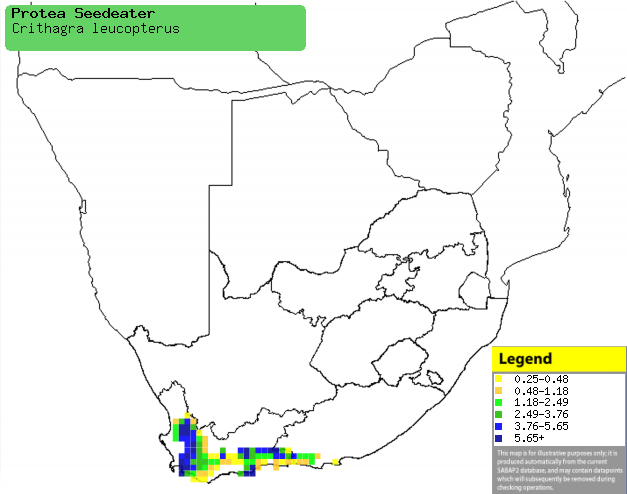|
Crithagra leucopterus (Protea
seedeater, Protea canary)
[= Serinus leucopterus]
Witvlerkkanarie [Afrikaans]; Witbandkanarie [Dutch]; Serin
bifascié [French]; Proteagirlitz [German]; Canário-d'asa-branca [Portuguese]
Life
> Eukaryotes >
Opisthokonta
> Metazoa (animals) >
Bilateria >
Deuterostomia > Chordata >
Craniata > Vertebrata (vertebrates) > Gnathostomata (jawed
vertebrates) > Teleostomi (teleost fish) > Osteichthyes (bony fish) > Class:
Sarcopterygii (lobe-finned
fish) > Stegocephalia (terrestrial
vertebrates) > Tetrapoda
(four-legged vertebrates) > Reptiliomorpha > Amniota >
Reptilia (reptiles) >
Romeriida > Diapsida > Archosauromorpha > Archosauria >
Dinosauria
(dinosaurs) > Saurischia > Theropoda (bipedal predatory dinosaurs) >
Coelurosauria > Maniraptora > Aves
(birds) >
Order: Passeriformes > Family: Fringillidae
Distribution and habitat
Endemic to the Western Cape and the western Eastern Cape of
South Africa, generally favouring mountain fynbos, edges of forest patches,
shrubs along rivers in fynbos and the border between Karoo and renosterveld
with scattered Waboom (Protea nitida) trees.
|
 |
|
Distribution of Protea seedeater in southern
Africa, based on statistical smoothing of the records from first SA Bird
Atlas Project (©
Animal Demography unit, University of
Cape Town; smoothing by Birgit Erni and Francesca Little). Colours range
from dark blue (most common) through to yellow (least common).
See here for the latest distribution
from the SABAP2. |
Movements and migrations
Generally resident and sedentary, although it makes local
movements in response to fire and the flowering and fruiting patterns of fynbos
plants.
Food
It mainly eats the seeds of fynbos plants, doing most of
its foraging on the ground in the foliage of shrubs and trees. The following food items have been recorded
in its diet:
- Plants
- seeds
- Protea
- P. neriifolia (Narrow-leaved protea)
- P. nitida (Waboom)
- P. repens (Suikerbos)
- Restio
- Senecio
- Cliffortia
- Diosma
- Elegia (golden curls)
- Erica
- Eriocephalus (Karoo rosemaries)
- Maytenus (silky-barks)
- Othonna
- Rhus (currants)
- Cliffortia cuneata
- foliage and flowers
- Aspalathus
- Chenopodium
- Cullumia
- Euryops
- Gymnodiscus
- Protea
- Ursinia pinnata (Magriet)
- Zygophyllum
- flowers
- Halleria elliptica (Rock tree-fuchsia)
- Erica plukenetti (Hangertjie)
- buds and flowers of Cliffortia ruscifolia (Climber's friend)
- fruit
- Kiggelaria africana (Wild-peach)
- Olea europea (African olive)
- Asparagus
- Diospyros
- Maytenus
- Oftia
- Pollichia
- Rhus
- nectar
- Erica
- Halleria
- Salvia
- Protea, such as P. repens (Suikerbos)
Breeding
- Monogamous solitary nester, with males calling from favoured perches in
its territory.
- The nest is a cup of everlasting (Helichrysum crispum) stems and
leaves, sparsely lined with Narrow-leaved protea (Protea neriifolia)
down. It is typically placed in a forked branch inside a Protea bush,
or occasionally in a Cluster pine (Pinus pinaster).
- Egg-laying season is from August-October.
- It lays 2-4 eggs, which are probably incubated solely by the female for
roughly 17 days.
- The chicks are fed by both parents, leaving the nest after about 14
days.
Threats
Not threatened, as the conservation status of mountain
fynbos is good, so it is well represented in protected areas.
References
-
Hockey PAR, Dean WRJ and Ryan PG 2005. Roberts
- Birds of southern Africa, VIIth ed. The Trustees of the John Voelcker
Bird Book Fund, Cape Town.
|
